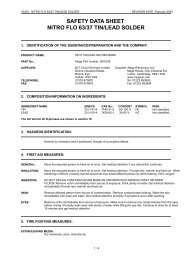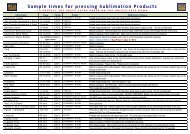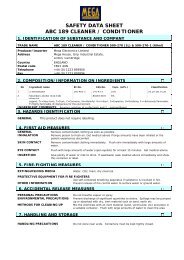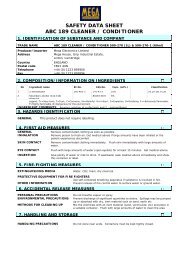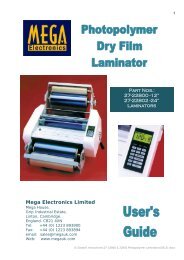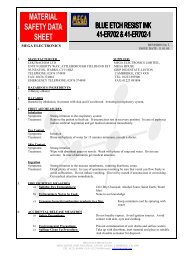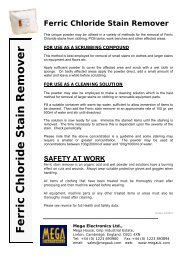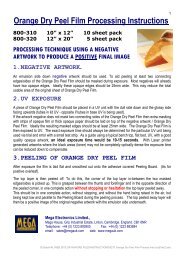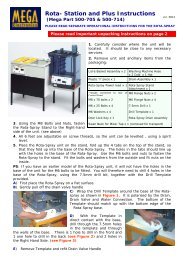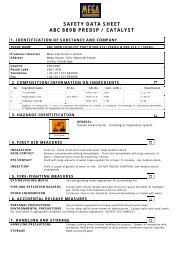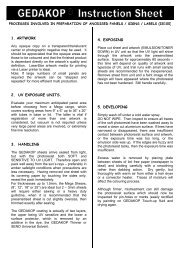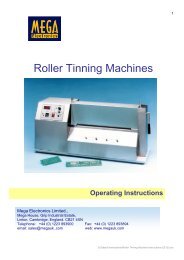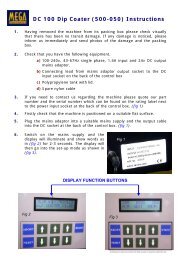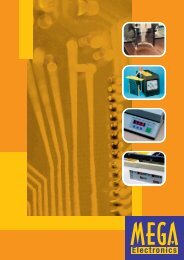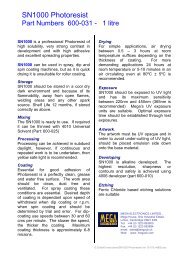5299_Data_Sheet_QMD(Quick-Mark_Digital ... - Mega Electronics
5299_Data_Sheet_QMD(Quick-Mark_Digital ... - Mega Electronics
5299_Data_Sheet_QMD(Quick-Mark_Digital ... - Mega Electronics
You also want an ePaper? Increase the reach of your titles
YUMPU automatically turns print PDFs into web optimized ePapers that Google loves.
<strong>Quick</strong>-<strong>Mark</strong>® <strong>Digital</strong> Specifications (<strong>QMD</strong>) Issue date: September 1, 2011 (updated 26/10/11)<br />
Description<br />
<strong>Quick</strong>-<strong>Mark</strong> <strong>Digital</strong> consists of a printable Laser Film, Base <strong>Sheet</strong>s and optional Over-Laminating films. The Laser<br />
Film is heat stabilised and includes a UV inhibitor to protect against fading and has a double sided coating to<br />
accept Laser Toner. Vinyl Base <strong>Sheet</strong>s are available in white and transparent and there is 0.2mm aluminium<br />
available. All Base <strong>Sheet</strong>s have a cross-linked acrylic adhesive on both sides. The self-adhesive optional clear<br />
Over-Laminating films are available as a clear or matt PVC vinyl and a Polycarbonate.<br />
<strong>Quick</strong>-<strong>Mark</strong> <strong>Digital</strong> Laser Film<br />
<strong>QMD</strong> Laser Film is a 100 micron base polyester film. This 140g/m² film produces high density images when used<br />
with a host of colour and mono laser printers. The film features UV inhibitors and a toner receptive coating on both<br />
sides of the base polyester. For the purposes of the various tests detailed in this document an HP colour LaserJet<br />
CP5220 A3 printer was used with HP proprietary toner.<br />
In all cases, all statements, technical information and recommendations herein are based on tests we<br />
believe to be reliable, but the accuracy or completeness thereof is not guaranteed. Before using, user shall<br />
determine the suitability of the product for its intended use, and user assumes all risk and liability<br />
whatsoever in connection therewith<br />
Plastic Base <strong>Sheet</strong>s all base sheets have a double sided acrylic adhesive.<br />
Superior quality, soft polymeric 75 micron vinyl films using the latest advances in PVC and pigment technology to<br />
offer improved dimensional stability and excellent long term durability. The wide range of light fast colours are<br />
suitable for long term interior or exterior applications of an outdoor exposure of 5-7 years.<br />
Make up<br />
Storage<br />
75 micron vinyl<br />
Adhesive Base - 30 micron base clear, permanent cross linking acrylic adhesive with<br />
137 gsm plain projected Kraft Release Liner.<br />
Adhesive Top Face - 40 micron base clear, permanent cross linking acrylic with 100<br />
micron clear polyethylene liner.<br />
Three years from packing date out of direct sunlight at 15ºC to 25ºC and 50% humidity.<br />
Tensile (Min.) 25.ON/mm² (Test method DIN 53445)<br />
Elongation (Min.) 250% (Test method DIN 53445)<br />
Dimension Stability<br />
Flammability<br />
150 x 150mm 48 hours/70ºC FINAT FT 14 Aluminium 16 hours.<br />
Top Face Adhesion <strong>Quick</strong> Tack (N/25mm) on stainless steel average value 16 (FTM 9)<br />
Peel 180º - 30 min (N/25mm) on stainless steel average value 13 (FTM 1)<br />
Shear 1KG 25 x 25mm > 500 hours (FTM 8)<br />
Chemical Resistance The following tests were carried out on the base film. A sample was prepared by<br />
applying the film to an aluminium panel at 23ºC and conditioning 24 hours prior to<br />
testing<br />
by immersion in the solutions. After a fixed period of time the sample is removed,<br />
dried<br />
and examined for adhesion one hour after test.<br />
Page 1 of 4
Solution/Reagent Exposure Results / Observations<br />
Humidity 300 hours No effects<br />
Water 24 hours immersion No effects<br />
Sea Water 1 year mid tide BS5609 No effects<br />
Diesel Fuel 24 hours immersion No effects<br />
Anti Freeze/water 24 hours immersion No effects<br />
Reference Fuel 1 hr immersion Very slight film softening<br />
SAE Motor Oil 24 hours immersion No effects<br />
Detergent Solution (65ºC) 8 hours immersion No effects<br />
Please read notes pertaining to tests at the end of this data sheet.<br />
Aluminium Base <strong>Sheet</strong>s<br />
High quality mill finish 0.2 mm aluminium.<br />
Make up<br />
1050 Alloy, Hard Temper.<br />
Double sided adhesive - both faces - 40 micron clear, permanent cross linked<br />
acrylic adhesive with 100 micron clear polyethylene liner.<br />
Storage Two years from packing date out of direct sunlight at 15ºC to 25ºC and 50%<br />
humidity.<br />
Application Temp.<br />
Service Temp.<br />
Clean dry surface, +2ºC to +50ºC<br />
Clean dry surface, -30ºC to +90ºC<br />
Adhesion (both faces) <strong>Quick</strong> Tack (N/25mm) on stainless steel average value 16 (FTM 9)<br />
Peel 180º - 30 min (N/25mm) on stainless steel average value 13 (FTM 1)<br />
Shear 1KG 25 x 25mm > 500 hours (FTM 8)<br />
Over-Laminating Films<br />
A matt and gloss over-laminating film are available. Both have a single sided acrylic adhesive and are designed to<br />
provide extra protection to a <strong>Quick</strong>-<strong>Mark</strong> label where the Imaging Film emulsion is left exposed on the top<br />
surface.<br />
The matt film can also be used to change the aesthetic appearance of a finished label to a matt anti-reflective<br />
appearance.<br />
Gloss<br />
Make Up<br />
Matt<br />
Make Up<br />
Storage<br />
Application Temp.<br />
Service Temp.<br />
The material and specification is the same as the transparent Base <strong>Sheet</strong><br />
expect it does not have a top surface adhesive.<br />
A matt 70 micron PVC film with 25 micron of acrylic adhesive protected by a yellow<br />
90g/m² yellow Kraft paper. The film has a matt appearance with anti-reflective properties.<br />
Two years from packing date at 15ºC to 25ºC and 50% humidity.<br />
Clean dry surface, +5ºC to +40ºC<br />
Clean dry surface, -30ºC to +90ºC<br />
Adhesion <strong>Quick</strong> Tack (N/25mm) on stainless steel average value 4 +/- 1 (FTM 9)<br />
Peel 180º - 30 min (N/25mm) on stainless steel aver. value 2.5+/-1 (FTM 1)<br />
Shear 1KG 25 x 25mm > 100 hours (FTM 8)<br />
Chemical Resistance The following tests were carried out on the base film. A sample was prepared by applying<br />
the film to an aluminium panel at 23ºC and conditioning 24 hours prior to testing by immersion in the solutions.<br />
After a fixed period of time the sample is removed, dried and examined for adhesion one hour after test.<br />
Solution/Reagent Immersion Time Results / Observations<br />
Water 24 hours Excellent<br />
5% Detergent 24 hours Excellent<br />
10% Sulphuric Acid 24 hours Excellent<br />
10% Phosphoric Acid 24 hours Good<br />
10% Sodium Hydroxide 24 hours Excellent<br />
10% Ammonium Hydroxide 24 hours Excellent<br />
Ethylene Glycol 24 hours Excellent<br />
Methanol 1 hour Good<br />
Please read notes pertaining to tests at the end of this data sheet.<br />
Page 2 of 4
Environmental Performance Testing<br />
Material submitted for Testing<br />
A reverse printed image was produced on <strong>QMD</strong> Laser Film via a HP colour LaserJet CP5220 A3 printer,<br />
loaded with proprietary HP toner. The printed images were adhered to 800-500 White Base <strong>Sheet</strong>s and<br />
the label stuck to an aluminium backing plate. Various samples 70mm x 190mm, 70mm x 150mm and<br />
100mm x 100mm were produced each consisting of the <strong>Mega</strong> Logo and bands of red, yellow, green,<br />
black, blue, orange and light blue colour. Each panel was covered by approximately 50%, by a piece of<br />
800-600 Gloss Over-Laminating Film.<br />
Chemical Resistance<br />
6 of the 70mm x 190mm labels were subjected to chemical resistance in accordance with BS EN ISO 2812-4<br />
(spotting method). The labels were exposed to water, mineral oil, industrial methylated spirit, white spirit, base at<br />
pH10 and acid at pH 4 for 4 hours. The method was modified slightly for the volatile methylated spirit by soaking a<br />
piece of filter board and applying this to the surface.<br />
Chemical Resistance Results<br />
Reagent<br />
Water<br />
Mineral Oil<br />
Industrial Methylated Spirit<br />
White Spirit<br />
Base at pH 10<br />
Acid at pH 4<br />
Appearance<br />
No change<br />
No change<br />
Softening of unlaminated surface leading to marring upon removal<br />
No change<br />
No change<br />
Very light abrasion of unlaminated surface upon removal<br />
Temperature Resistance<br />
70mm x 190mm labels were subject to freeze-thaw testing consisting of 7 cycles of 8 hours to -20°C.<br />
70mm x 190mm labels were subject to 80°C for 2 hours.<br />
70mm x 190mm labels were subject to 90°C for 2 hours.<br />
70mm x 190mm labels was not reversed printed (toner on top) and over-laminated with 800-600 Gloss Laminating<br />
Film was subject to 90°C for 2 hours.<br />
At the end of test cycles the labels were visually examined and adhesion of the labels to the aluminium panel was<br />
tested by trying to peel off the label by hand.<br />
Temperature Resistance Results<br />
No apparent loss of adhesion on any label.<br />
No apparent change in appearance to the freeze-thaw labels (-20C)<br />
No apparent change in appearance to the label tested to 80°C<br />
Softening of colours and slight mottled appearance to the label tested to 90°C. Close examination showed the<br />
change in appearance to be due to find porosity in the toner.<br />
No apparent change in appearance to the label that was not reversed printed (toner on top) and over-laminated<br />
with 800-600 Gloss Laminated film that was tested to 90°C.<br />
Abrasion Resistance<br />
The 100mm x 100mm self-adhesive labels were mounted to steel backing plates and subjected to Taber abrasion<br />
testing in accordance with BS EN ISO 7784-2, using CS17 wheels each with a load of 1000g. The weight loss was<br />
determined after 750 cycles.<br />
Abrasion Resistance Results<br />
Panel Weight loss (mg) Appearance<br />
1 44 Surface abrasion during testing has caused loss of gloss and softening of<br />
2 36 the colours. The effect is similar for both the laminated and unlaminated<br />
3 36 areas.<br />
Page 3 of 4
Resistance to Humidity<br />
3 of the 70mm x 190mm labels were subjected to a controlled environment of 32°C and 95% RH for 72 hours. At<br />
the end of this period the panels were visually examined and adhesion of the labels to the aluminium panel was<br />
tested as for the temperature resistance samples.<br />
Resistance to Humidity Results<br />
The panels showed no change in colour or gloss upon completion of testing, with no apparent loss of adhesion<br />
Salt Spray<br />
3 of the 70mm x 190mm labels were exposed to neutral salt spray in accordance with BS EN ISO 9227 for 48<br />
hours. At the end of this period the panels were visually examined and adhesion of the labels to the aluminium<br />
panel was tested as for the temperature resistance samples.<br />
Salt Spray Results<br />
The panels showed no change in colour or gloss upon completion of testing, with no apparent loss of adhesion.<br />
Artificial Weathering<br />
The 70mm x 150mm samples were subjected to QUVA exposure in accordance with BS EN ISO 11507 using UVA<br />
340 lamps and a weathering cycle of 4 hours condensation at 50°C followed by 4 hours UV exposure at 60°C. The<br />
panels were exposed for 1000 hours with an intermediate inspection at 500 hours.<br />
Artificial Weathering Results<br />
The unlaminated areas of the labels showed loss of gloss and softening of the colours due to surface mottling after<br />
500 hours exposure, with little further change after 1000 hours.<br />
The gloss and colour of the laminated areas appear unaffected.<br />
Although the amount of UV light in natural weather conditions varies immensely 500 QUVA exposure has been<br />
previously attributed to 15 months UK natural exposure (45° facing South)<br />
Test Notes<br />
1. FTM denotes FINAT test methods, which are used as standards throughout the European adhesive<br />
labelling industry. FINAT is short for:<br />
FÉDÉRATION INTERNATIONALE DES FABRICANTS ET TRANFURMATEURS D'ADHÉSIFS ET<br />
THERMOCOLLANTS SUR PAPIERS ET AUTRES SUPPORTS.<br />
2. In all cases, all statements, technical information and recommendations herein are based on<br />
tests we believe to be reliable, but the accuracy or completeness thereof is not guaranteed, and the<br />
following is made in lieu of all warranties of merchantability and fitness for purpose:<br />
Sellers and manufacturers only obligation shall be to replace such quantity of the product proved to be<br />
defective. Before using, user shall determine the suitability of the product for its intended use, and user<br />
assumes all risk and liability whatsoever in connection therewith. NEITHER THE SELLER NOT<br />
MANUFACTURER SHALL BE LIABLE EITHER IN TORT OR IN CONTRACT FOR ANY LOSS OR<br />
DAMAGE, DIRECT, INCIDENTAL, OR CONSEQUENTIAL, ARISING OUT OF THE USE OF OR THE<br />
INABILITY TO USE THE PRODUCT. No statement or recommendation not contained herein shall have<br />
any force or effect unless in an agreement signed by officers of seller and manufacturer.<br />
<strong>Quick</strong>-<strong>Mark</strong>® is a trademark of <strong>Mega</strong> <strong>Electronics</strong> Ltd.<br />
G:\<strong>Data</strong>\<strong>Quick</strong>-<strong>Mark</strong>\Spec <strong>Sheet</strong>s\<strong>Quick</strong> <strong>Mark</strong> <strong>Digital</strong> Spec. sheets(0911).doc<br />
Page 4 of 4



